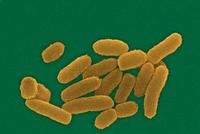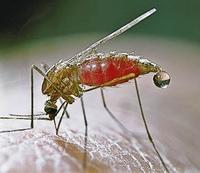-
Biological weapons: U.S. must not repeat the failure of imagination
Joel McCleary, a biological weapons expert, is the chairman and co-founder of Q Global and the founder of PharmAthene; he argues that the U.S. government has not done enough to protect the nation against a biological attack, warns of the need for presidential leadership, and underscores the dangers of biological weapons
-
-
Emergency medical response in a post-9/11 Washington, D.C.
Beverly Pritchett, the senior deputy director of the Health Emergency Preparedness and Response Administration at the D.C. Department of Health, is a 27-year veteran of the U.S. Army Medical Service Corps; Pritchett discusses improvements made to the city’s emergency medical response capabilities, the integration of smartphones and social media into disaster response plans, and the need for continued funding to sustain the gains made in public health over the past ten years
-
-
Simple solution for removing arsenic from water

Almost 100 million people in developing countries are exposed to dangerously high levels of arsenic in their drinking water, unable to afford complex purification technology; scientists developed a simple, inexpensive method for removing arsenic based on chopped up pieces of ordinary plastic beverage bottles coated with a nutrient found in many foods and dietary supplements
-
-
Scientists "domesticate" -- and disarm -- malaria parasite
Malaria is one of the Earth’s most notorious scourges, accounting for more than 250 million new cases — and one million deaths — each year, researchers have developed a novel technique to “tame” the malaria parasite by forcing it to depend on an external supply of a vital chemical; this could help to speed up drug development and provide the basis for the first effective vaccine against malaria
-
-
Lawmakers struggling to end critical medicine shortage
Critical shortages for medicines needed in treating life-threatening illnesses have lawmakers and public health officials scrambling to find solutions; this year alone, a record high of more than 180 drugs crucial for treating childhood leukemia, breast and colon cancer, infections, and other diseases have been declared in short supply
-
-
Anthrax forensics help ID source of Haitian cholera outbreak
Researchers have discovered the source of the deadly cholera outbreak in Haiti that killed more than 6,000 people and sickened 300,000; the study determined that Nepalese peacekeepers brought cholera to Haiti, when they came to assist the country’s rebuilding efforts following the massive earthquake in January 2010
-
-
How did the deadly plague bacterium develop?

In a relatively short time — in evolutionary terms — a bacterium that causes mild stomach irritation evolved into a deadly pathogen responsible for the most devastating pandemics in human history; how did the mild-mannered Yersinia pseudotuberculosis become Yersinia pestis, more commonly known as the Plague? New study explains what happened — and sheds light on fighting deadly diseases
-
-
Experts anxious about appearance of a variant strain of Bird Flu

Since 2003 H5N1 has killed or forced the culling of more than 400 million domestic poultry and caused an estimated $20 billion of economic damage across the globe before it was eliminated from most of the sixty-three countries infected at its peak in 2006; the UN health agency now calls for increased preparedness and surveillance against a re-emerging variant strain of H5N1
-
-
The malaria mosquito is disappearing – researchers wonder why

The incidence of malaria in many African countries south of the Sahara is falling rapidly; a research group has discovered that the mosquito carrying the malaria parasite has practically disappeared from villages without organized mosquito control; there are several hypotheses about the cause of the decline, but without proper data researchers cannot say whether malaria is being eradicated or whether it is just resting up before returning with renewed vigor
-
-
Common bacterium stops mosquitoes from transmitting Dengue virus
Strains of a bacterium commonly found in fruit flies can prevent the Aedes aegypti mosquito from transmitting the virus that causes dengue fever, researchers have found; the discovery could lead to a more effective way to control dengue worldwide
-
-
Overcoming dangerous antibiotic-resistant bacteria
Scientists have successfully reengineered an important antibiotic to kill the deadliest antibiotic-resistant bacteria; the compound could one day be used clinically to treat patients with life-threatening and highly resistant bacterial infections
-
-
Coriander oil tackles food poisoning and drug-resistant infections
Coriander oil has been shown to be toxic to a broad range of harmful bacteria; its use in foods and in clinical agents could prevent food-borne illnesses and even treat antibiotic-resistant infections, according to the authors of a study published in the Journal of Medical Microbiology
-
-
Source of Haitian cholera outbreak identified
Employing technology that reads the entire DNA code, researchers have pinpointed the source of a cholera outbreak in Haiti that killed more than 6,000 people and sickened 300,000; the researchers also suggest how to prevent future outbreaks when international aid is rushed to disaster areas
-
-
Tap water in Copenhagen contaminated with E.coli
Parts of the Danish capital Copenhagen were without clean drinking water Saturday after high levels of the E.coli bacteria were detected in the municipal tap water system
-
-
Cleaning water while generating energy
A fuel cell system that can generate electricity from organic compounds and clean up wastewater at the same time has been developed by scientists in China; the cell uses light energy to degrade organic compounds in wastewater, generating electrons that pass through to the cathode, which converts the chemical energy into electrical energy
-
More headlines
The long view
We Ran the C.D.C.: Kennedy Is Endangering Every American’s Health
Nine former leaders of the Centers for Disease Control and Prevention (CDC), who served as directors or acting directors under Republican and Democratic administrations, serving under presidents from Jimmy Carter to Donald Trrump, argue that HHS Secretary Roert F. Kennedy Jr. poses a clear and present danger to the health of Americans. He has placed anti-vaxxers and conspiracy theorists at top HHS positions, and he appears to be guided by a hostility to science and a belief in bizarre, unscientific approaches to public health.
